The frozen St. Lawrence River has been a means for safely transiting from island to island in winter. Our winters historically seemed colder and longer, which resulted in widespread freezing of the St. Lawrence River. Locals cut ice from the River, stacked it in icehouses and packed it in sawdust, for use during the summer season as refrigeration. Locals also raced horses, sulkies, and cars on the frozen River. Buildings and barns were moved across the River on the thick ice from island to island or to or from the mainland. This River ice also gave birth to iceboats as a means to safely cross the frozen body of water.
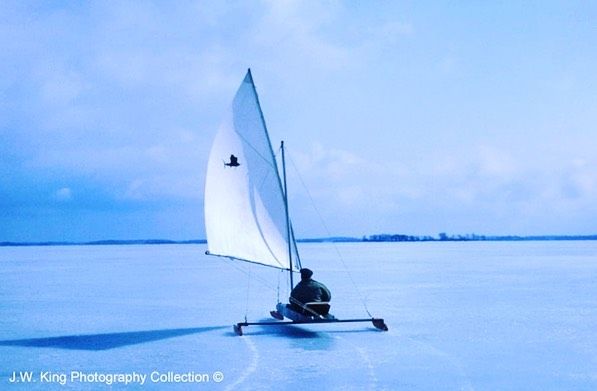
Initially, iceboats were powered by sails. These fragile sailing craft could reach speeds of 40 miles per hour or more. Manley Rusho recently wrote an article in Thousand Island Life about such a sailing iceboat that his family and friends restored and sailed from Grindstone Island to Clayton, and to Carlton Island.
While fast, these sail-driven iceboats were not capable of carrying much weight, and were not very stable. They were better designed for racing and recreation, rather than providing practical transit from island to island. Today, these sail-propelled iceboats are raced on lakes in areas such as Michigan and Wisconsin. Modern rigs can reach very high speeds, and most carry only the helmsman.
Introduction of internal combustion engines eventually made their way into iceboat design. With rivers and lakes frozen over, propulsion by propellors immersed in water wasn’t feasible. So, builders turned to aircraft or automotive engines to turn airplane props to drive their iceboats. While loud and somewhat dangerous, this air-cooled propulsion system could drive these punt-shaped craft at high speeds – perhaps as fast as 100 miles per hour. Rudders mounted behind the engine and propellor provided some ability to turn. And since the props could not be reversed, there was no practical way to brake and stop these airboats. Helmsmen had to coast to a sto. Therefore, it required a judicious use of throttle as one approached docks and the shoreline.
While a solidly frozen river was desirable, the St. Lawrence often had open water where current and wind fought thick ice formation. Therefore, iceboats had to be capable of running through open water, as well as on top of the ice. Early iceboats were built of wood, so steel or stainless runners were needed to keep the ice from damaging the plywood or fiberglass sheathing of the boat hull. The steel runners also provided directional stability. Some models were sheathed in galvanized steel to protect the wooden hull.
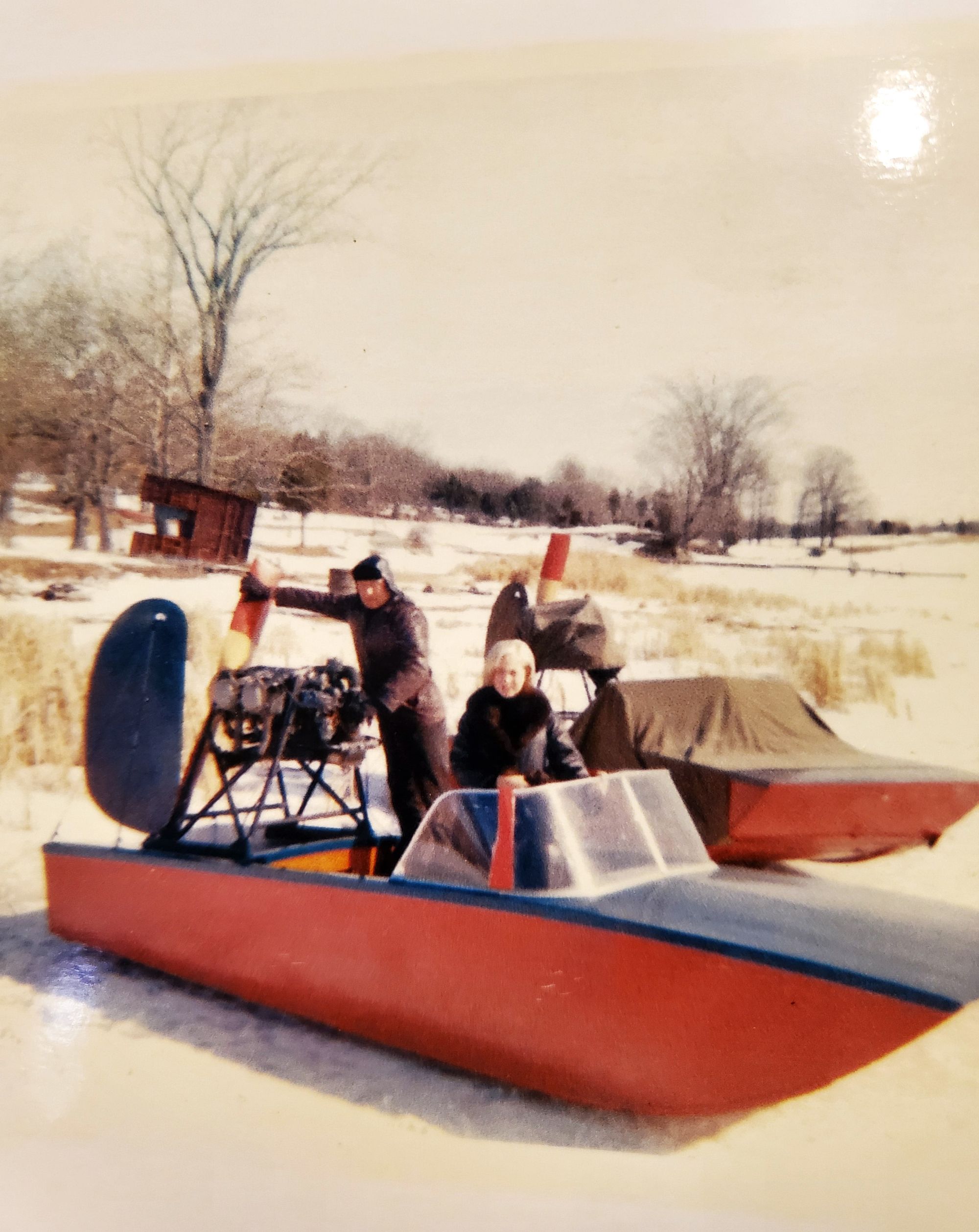
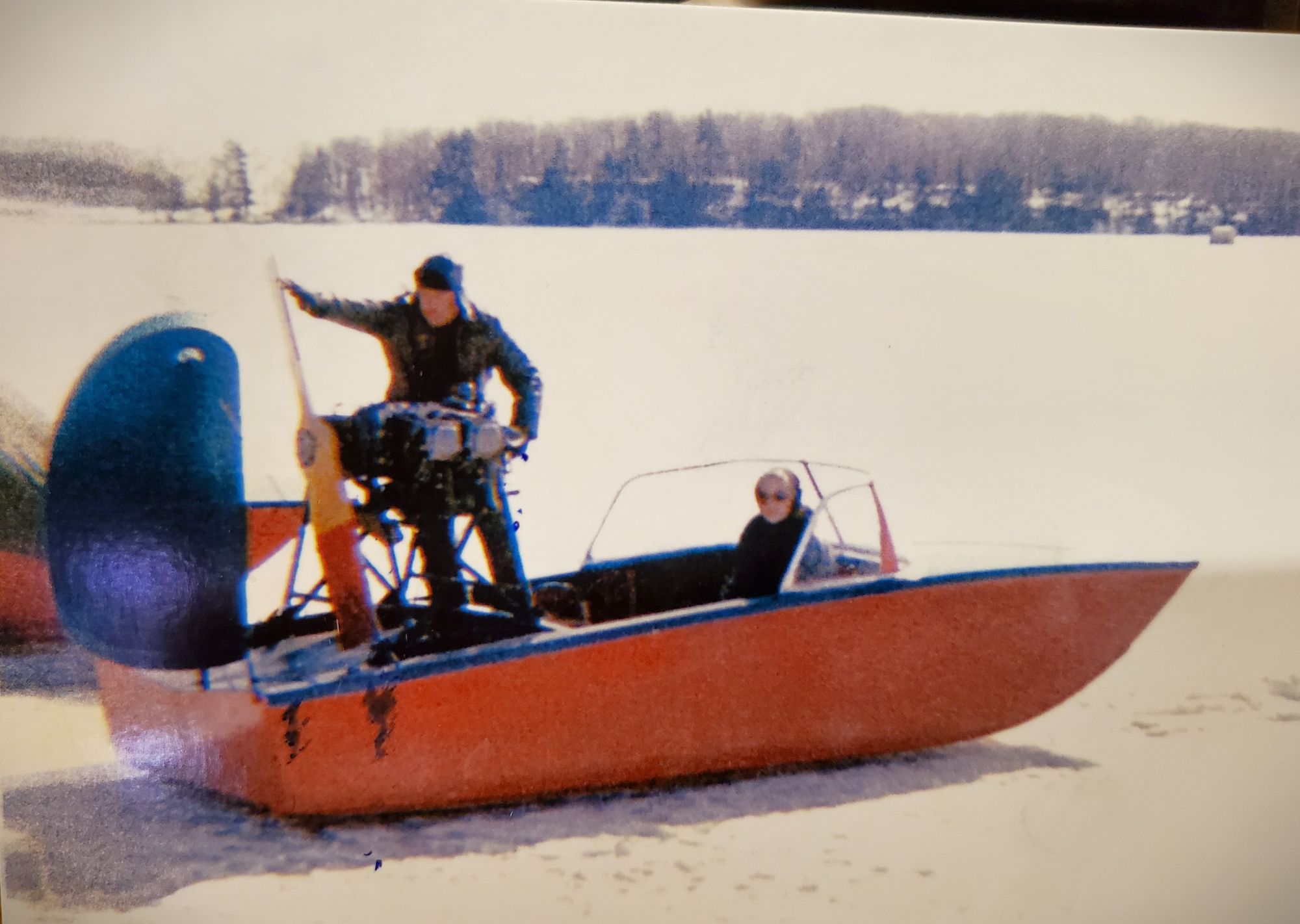
My recent article on the iceboat built by Vaino Anderson of Grindstone Island discussed the experience of riding in these vessels across the frozen river. You had little turning ability at slow speeds, so the helmsman needed higher velocity for control. So, a fast and exciting ride was the norm. Moving across the ice also resulted in ice crystals being thrown up from the runners, so it was a very cold, very icy ride. Vaino’s wife Mary and daughter Sylvia used a tarp or blanket to get some protection from the frigid air and stinging ice pellets. But Vaino sat high on the helm seat and was fully exposed to cold and the elements. He was often coated in ice by the end of a trip. In winter, Sylvia’s father took her to and from Clayton for school in their iceboat. A very exciting ride to be sure!
Other River residents also built iceboats. We found an article by Tom Robbins in the March, 2021 issue of Thousand Island Life, about the residents of Pine Island (aka Beckwith Island) who would inspect their lovely French provincial home in the winter by taking an iceboat. This iceboat had a galvanized steel bottom for protection against chafe from the sharp frozen river. Island owner Sallie Robbins, who was compared to tall, blonde movie stars of the day, often made the iceboat trip from Clayton to Pine Island dressed only in a simple overcoat and in street shoes. How she and husband Bill avoided frostbite is still a mystery.
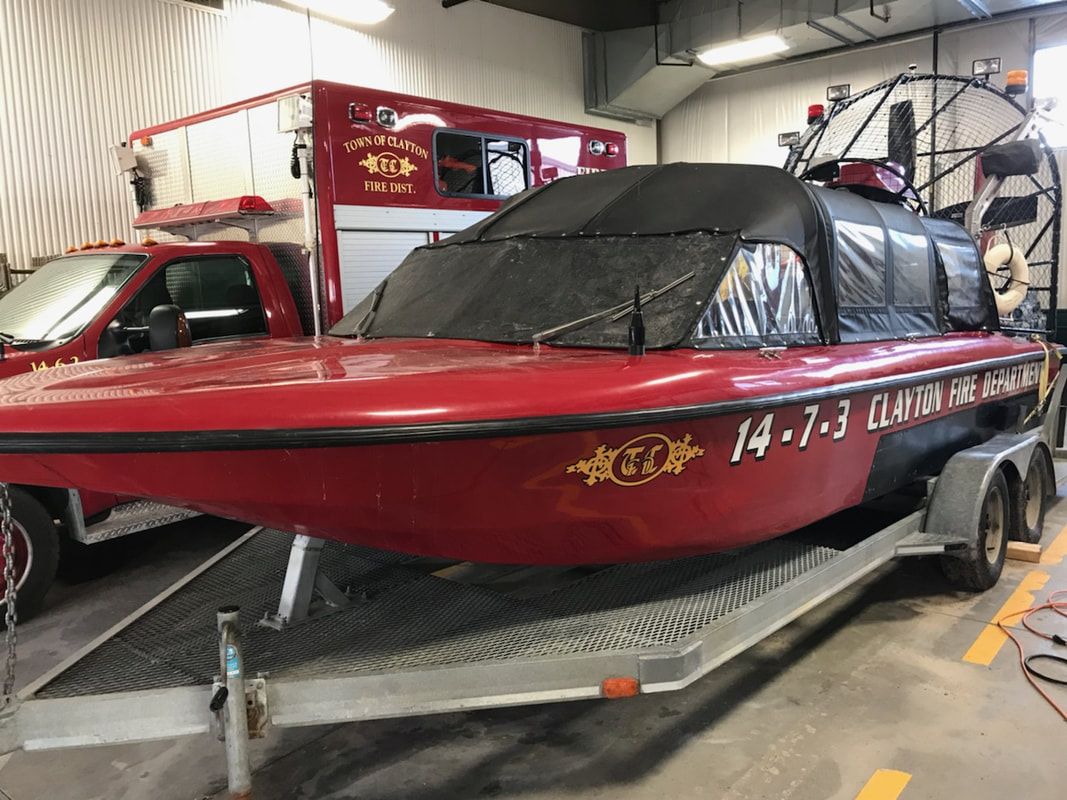
The Clayton Fire Department has a very modern iceboat for rescue use during winter weather. The hull is fiberglass, and the cockpit is fully enclosed in canvas and eisenglass. The large four-blade propellor is enclosed in a safety cage. The fire department keeps their iceboat in their heated firehouse on a trailer. It can be launched when emergencies dictate. This iceboat was built by a company that specializes in rescue watercraft.
There is a company in Wisconsin that builds iceboats for recreational and commercial use. They built an 18-foot Sportsman model that is powered by a 7-litre automobile engine producing 520 horsepower. It has many options, including a fully-enclosed cockpit, cabin heat, hydraulic braking, and even a welded aluminum hull. This is a far cry from the homebuilt iceboats of River residents like Vaino Anderson. But of course, this modern iceboat comes with a big price tag – in excess of $160,000.
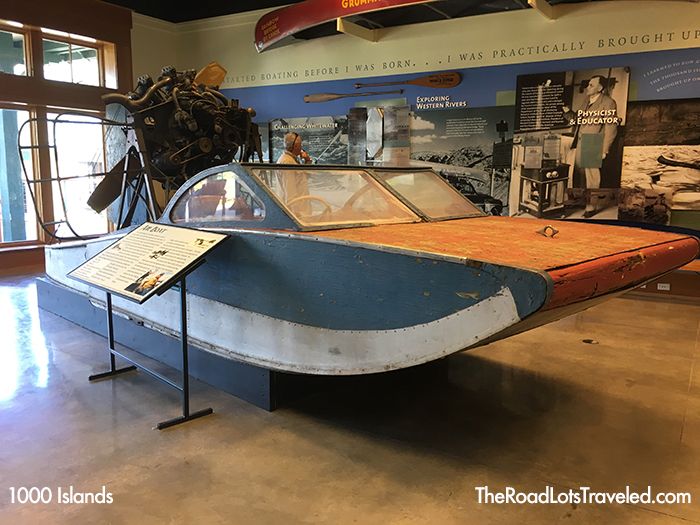
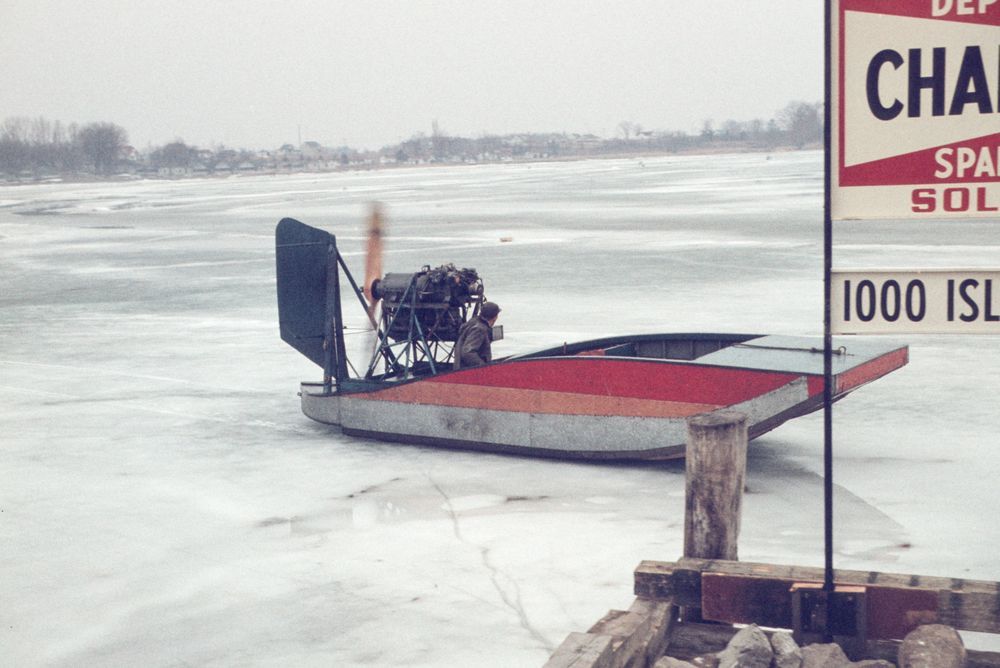
Snowmobiles offer another way for River rats to move across the frozen River and snow. They are fast, maneuverable, and capable of hauling goods, supplies, and gear to and from islands, ice fishing spots, as well as for recreation. They have advantages over iceboats, but of course can’t transit open water where the River is not frozen. We have all heard of snowmobiles (as well as automobiles) breaking through thin ice and sinking into the River. Hopefully, the owners and passengers escaped without harm.
The hardy year-round residents on islands like Grindstone have to prepare for the long winter. With no bridges like Wellesley Island, or a ferry like Wolfe Island, these island folks need to be self-sufficient. Some sturdy steel or modern aluminum vessels may be able to reach the islands in winter ice. This would be especially true if a serious ice storm knocked out electric power service to islands where folks live all winter. Fire departments have the ability to make rescues in or on river ice, using their iceboats. Home-built iceboats may be something of the past, but they served a need that existed when we had a thick frozen river, and long, cold winters.
By Rick Casali
Rick Casali is a resident of Wellesley Island. During his youth, from 1947 to 1976, his parents had a cottage on Grindstone Island named The Orchards. Rick now splits his time between Stuart, FL and the River. He worked for Columbia Gas System for 29 years and ran their Washington, DC office. Then in 2000, he started brokering boats and yachts, and continues as a broker with North Point Yacht Sales. Rick and his wife Anne cruise the River in a Seaway 24 Seafarer named "Miss Annie", and they live on Tennis Island.
Be sure to see more of Rick Casali's tributes and reviews. He has now written over 18 articles for TI Life, and they are not only interesting but also provides an important historical review of River life.
Posted in: Volume 19, Issue 3, March 2024, Nature, Sports
Please click here if you are unable to post your comment.
